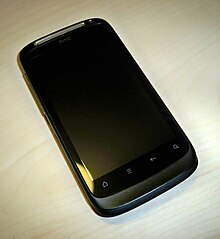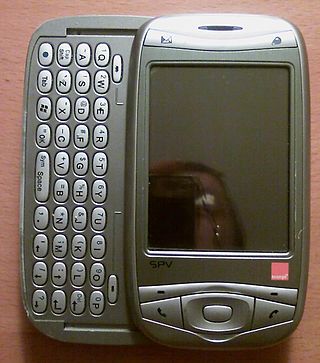
The HTC Wizard is an Internet-enabled Windows Mobile Pocket PC smartphone designed by High Tech Computer Corporation of Taiwan. It has a touchscreen with a left-side slide-out QWERTY keyboard. The Wizard's functions include those of a camera phone and a portable media player in addition to text messaging and multimedia messaging. It also offers Internet services including e-mail, instant messaging, web browsing, and local Wi-Fi connectivity. It is a quad-band GSM phone with GPRS and EDGE. There are variants which differ in the design of the case, the keyboard and the presence of an on-board camera. On AT&T/Cingular, the Wizard was superseded by the HTC TyTN, known as the AT&T/Cingular 8525. On T-Mobile USA, the Wizard was superseded by the HTC P4350, known as the T-Mobile Wing.

The HTC Universal is a Windows Mobile 5.0 Pocket PC PDA manufactured by High Tech Computer Corporation. It was the first 3G/UMTS-enabled Pocket PC PDA with a telecommunications function, and also the first to come with Windows Mobile 5.0 pre-installed.

The HTC TyTN is an Internet-enabled Windows Mobile Pocket PC PDA designed and marketed by High Tech Computer Corporation of Taiwan. It has a touchscreen with a left-side slide-out QWERTY keyboard. The TyTN's functions include those of a camera phone and a portable media player in addition to text messaging and multimedia messaging. It also offers Internet services such as e-mail, instant messaging, web browsing, and local Wi-Fi connectivity. It is a quad-band GSM phone with GPRS, and EDGE, and a single/dual band UMTS phone with HSDPA. It is a part of the first line of PDAs directly marketed and sold by HTC. On AT&T/Cingular, the TyTN was the successor to the HTC Wizard, known as the Cingular 8125. Also on AT&T, the TyTN was superseded by the HTC TyTN II, known as the AT&T 8925 and the AT&T Tilt.

The HTC TyTN II is an Internet-enabled Windows Mobile Pocket PC smartphone designed and marketed by HTC Corporation of Taiwan. It has a tilting touchscreen with a right-side slide-out QWERTY keyboard. The TyTN II's functions include those of a camera phone and a portable media player in addition to text messaging and multimedia messaging. It also offers Internet services including e-mail, instant messaging, web browsing, and local Wi-Fi connectivity. It is a quad-band GSM phone with GPRS, EDGE, UMTS, HSDPA, and HSUPA.

The HTC Dream is a smartphone developed by HTC. First released in October 2008 for $179 with a 2-year contract to T-Mobile, the Dream was the first commercially released device to use the Linux-based Android operating system, which was purchased and further developed by Google and the Open Handset Alliance to create an open competitor to other major smartphone platforms of the time, such as Symbian, BlackBerry OS, and iPhone OS. The operating system offers a customizable graphical user interface, integration with Google services such as Gmail, a notification system that shows a list of recent messages pushed from apps, and Android Market for downloading additional apps.
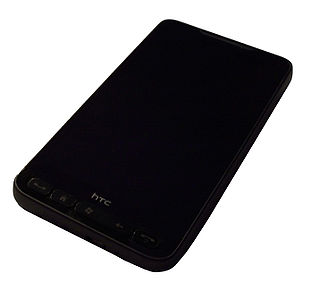
The HTC HD2, is a smartphone in the HTC Touch family designed and manufactured by HTC. The HD2 natively runs the Windows Mobile 6.5 operating system, and was released in Europe in November 2009, in Hong Kong in December 2009, and in other regions including North America in March 2010. The phone is the successor to the HTC Touch HD, and is succeeded by the HTC HD7.

The Sony Ericsson Xperia X10 is a 2010 high end smartphone in the Xperia series designed by Sony Ericsson. It was the first Sony Ericsson smartphone to run the Android operating system, and was designed to be the successor of the Xperia X2. The phone was shipped with Android 1.6 (Donut), but an upgrade to 2.1 (Eclair) was made available starting 31 October 2010, with a gradual international rollout. Originally, Sony Ericsson stated that the X10 would not receive an upgrade to Android 2.2 (Froyo) or beyond, but the phone was later upgraded to 2.3.3 (Gingerbread) with the updates starting on 29 July 2011.

The HTC Desire is the first smartphone of the Desire series developed by HTC. It was announced on 16 February 2010 and released in Europe and Australia in the second quarter of the same year. The HTC Desire was HTC's third flagship phone running Android 2.1 Eclair which can be upgraded to 2.2 Froyo or 2.3 Gingerbread. Internally it bears a strong resemblance to the Nexus One, but differs in some features.

The HTC Evo 4G is a smartphone developed by HTC Corporation and marketed as Sprint's flagship Android smartphone, running on its WiMAX network. The smartphone was launched on June 4, 2010. It was the first 4G enabled smartphone released in the United States.

The HTC Aria is a smartphone manufactured by HTC Corporation that runs the Android operating system with HTC Sense.
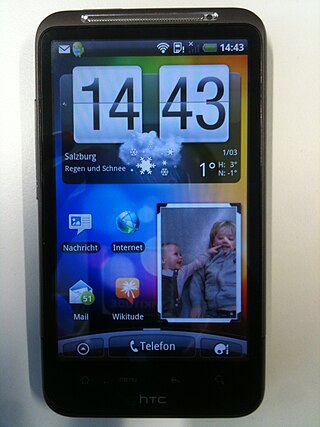
The HTC Desire HD is an Android smartphone by HTC Corporation. It was unveiled at a press event in London hosted by HTC on September 15, 2010, and was made available for sale in October in Europe and in January 2011 in Canada. The Desire was HTC's fourth flagship Android device until the release of their new line of flagship model, the HTC Sensation.

The Samsung Galaxy 3, also known as the Samsung Galaxy Apollo, Samsung Galaxy Mini in Italy, or Samsung Galaxy 580 in Hong Kong, is a smartphone manufactured by Samsung that runs the open source Android operating system. Announced and released by Samsung in July 2010, the Galaxy 3 succeeds the Samsung Galaxy Spica.

The Nexus S is a smartphone co-developed by Google and Samsung and manufactured by Samsung Electronics for release in 2010. It was the first smartphone to use the Android 2.3 "Gingerbread" operating system, and the first Android device to support Near Field Communication (NFC) in both hardware and software.
The HTC Evo Shift 4G is a smartphone developed by HTC Corporation and marketed as the concurrent/sequel to Sprint's flagship Android smartphone, running on its 4G WiMAX network. The smartphone launched on January 9, 2011.

The HTC Sensation is a smartphone designed and manufactured by HTC Corporation that runs the Android 2.3 Gingerbread software stock. Officially announced by HTC on April 12, 2011, the HTC Sensation was launched by Vodafone in key European markets including the United Kingdom on May 19, 2011 and by T-Mobile in the United States on June 12, 2011. It was HTC's fifth flagship Android phone and the first HTC phone to support the HTC Sense 3.0 user interface. At the time of its release, the Sensation XE was the world's fastest Android phone.

The HTC Incredible S (S710E) (s710d), also known as the Incredible 2, is a smartphone designed and manufactured by Taiwan's HTC Corporation originally running the Android 2.2 operating system. Officially announced by HTC on February 15, 2011 at MWC 2011 in Barcelona, Spain, alongside the HTC Desire S and the HTC Wildfire S, the HTC Incredible S was launched exclusively in the UK to Carphone Warehouse and Best Buy on February 26, 2011 marketed by Sarah Harding of Girls Aloud.

The T-Mobile myTouch 4G Slide is a touchscreen slider smartphone designed and manufactured by HTC Corporation for T-Mobile USA's "myTouch" series of phones. It is the fourth of the myTouch family. The myTouch 4G Slide is the first myTouch to feature HTC Espresso 3.0, a graphical user interface similar to HTC Sense 3.0. Highlights include an 8-megapixel camera, the Genius Button, and a hardware keyboard.
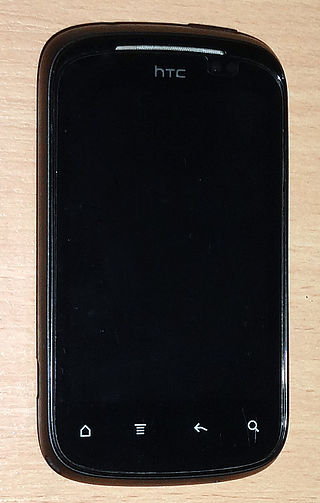
The HTC Explorer, code-named Pico, is a smartphone developed by the HTC Corporation that was released in October 2011. Because of the low end processor, the HTC Watch movie rental service and the 3D scrolling effects on the home screens were not available. The handset was available in four varieties of color options. Visually similar to the HTC Wildfire S, it comes with a 3.2-inch screen, a 600 MHz ARMv7 Qualcomm Snapdragon processor and runs Android version 2.3 (Gingerbread), bundled with the proprietary HTC Sense 3.5 user interface.

The HTC One S is a premium smartphone designed and manufactured by HTC as part of the HTC One series which has Beats Audio and runs the Android 4.0 "Ice Cream Sandwich" mobile operating system with HTC Sense. Announced by HTC on 26 February 2012, the HTC One S was scheduled for official release on 2 April 2012. The first phones were sold on March 30. In the United States, the One S is carried by T-Mobile and Solavei.
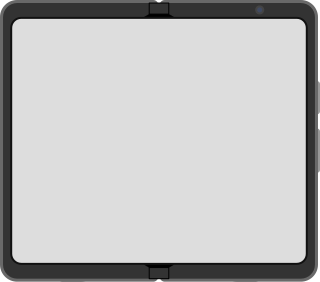
The following is a comparative list of smartphones belonging to the Google Pixel line of devices, all using the Android operating system.
